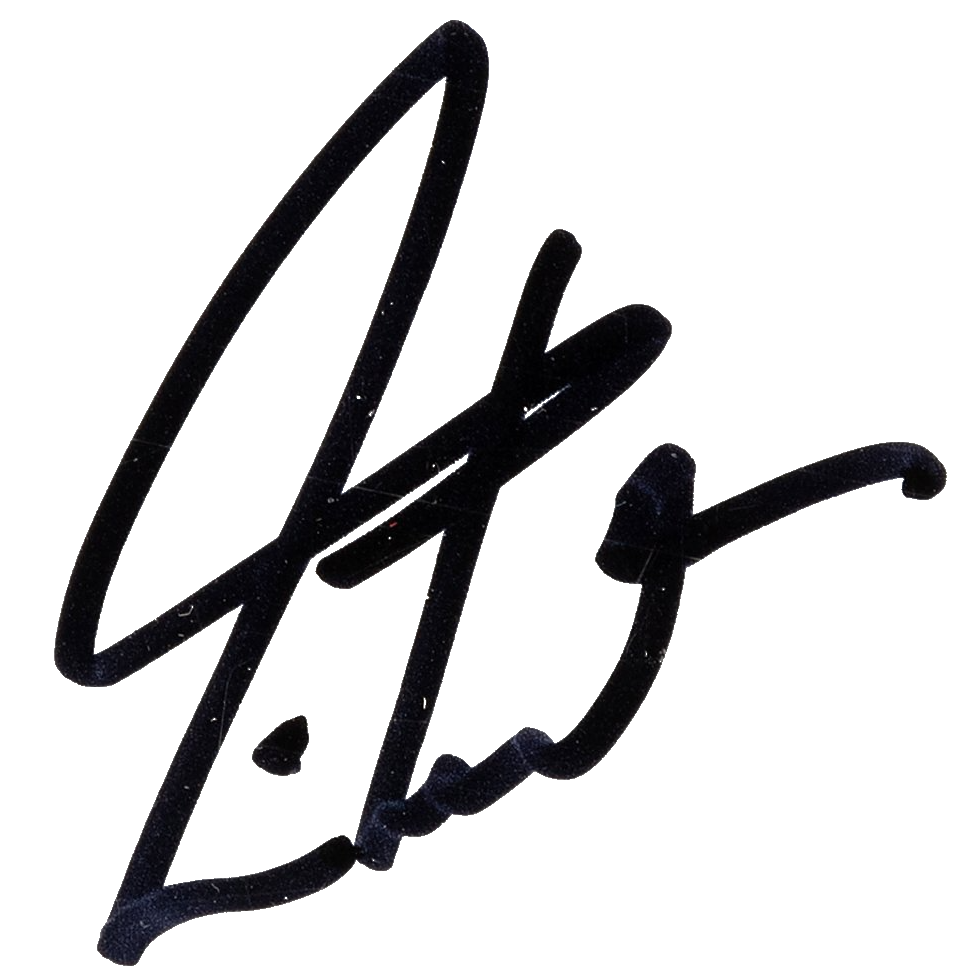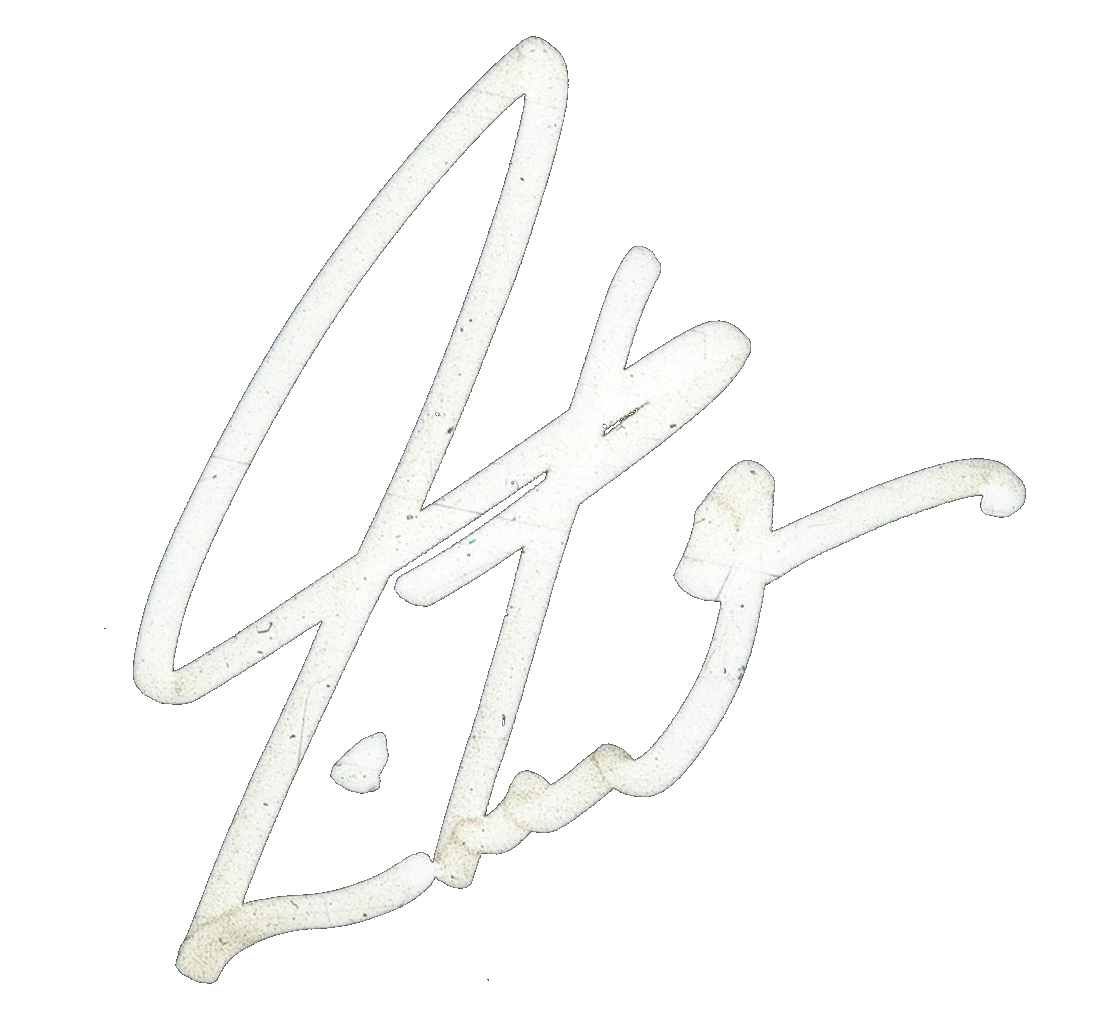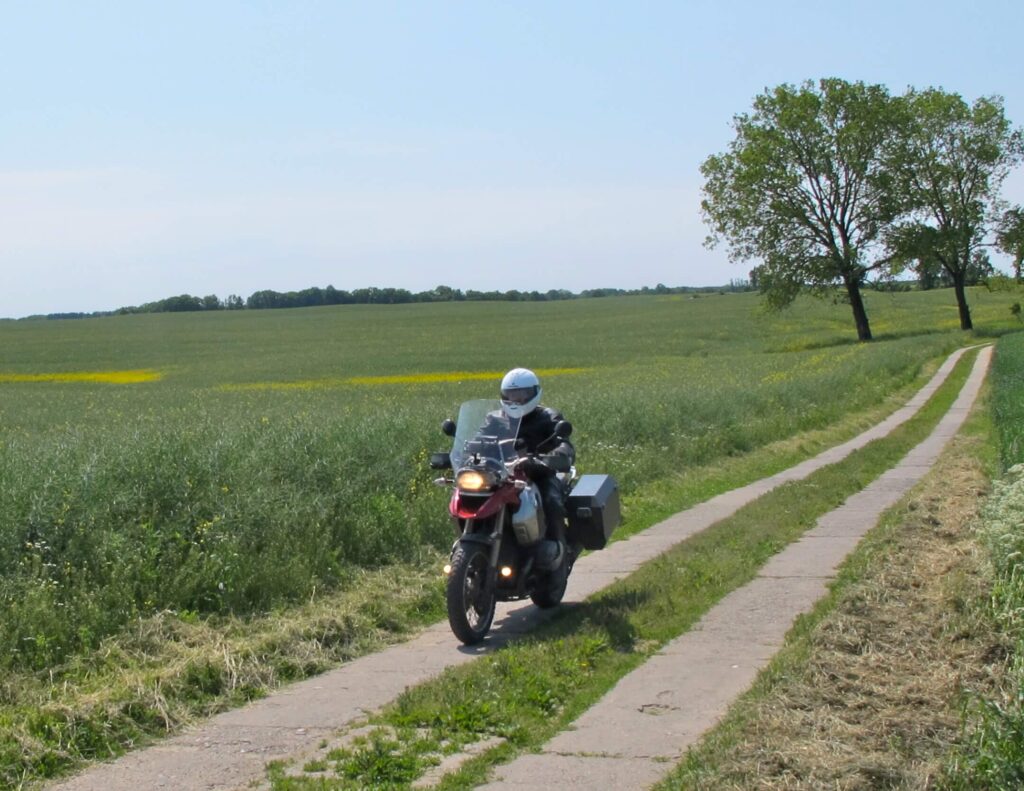
If East Germany has regained much of its prosperity and joie de vivre in the past twenty years, Poland, alas, has not been so fortunate. On a previous tour Brutus and I had ridden through a small part of Poland, and hadn’t been impressed, but figured that taste was too limited a “sample” to form any worthwhile impressions. This time we covered quite a lot more territory, riding all day through the villages and countryside, and even along some seaside resorts in the direction of the port of Gdynia, where we would catch an overnight ferry to Sweden.
We viewed the country the way we experience everywhere we visit, by the backroads, farmlands, villages, and small towns, and at the end of that day, the best Brutus and I could say was . . . the weather was nice.
We passed through miles of rather scruffy farmland and pulpwood tree plantations, all in ordered rows of a single species. Those vast tree farms had been planted about fifty or sixty years ago, so during the communist era—maybe to keep the soldiers busy enough not to be launching coups d’état.
As in much of Northern Europe, wind turbines were sprouting everywhere, and that could be considered an admirable sign of modernization. To the eye of this beholder, those gigantic white propellers do not add to a landscape’s beauty—but that is why they are most often placed where the landscape does not possess much beauty. The farms and villages were charmless, drably painted and without much in the way of parks, gardens, or decorations—save for the signature stork nests, great bundles of sticks built on platforms erected by the community, because a nesting stork is considered to be good luck.
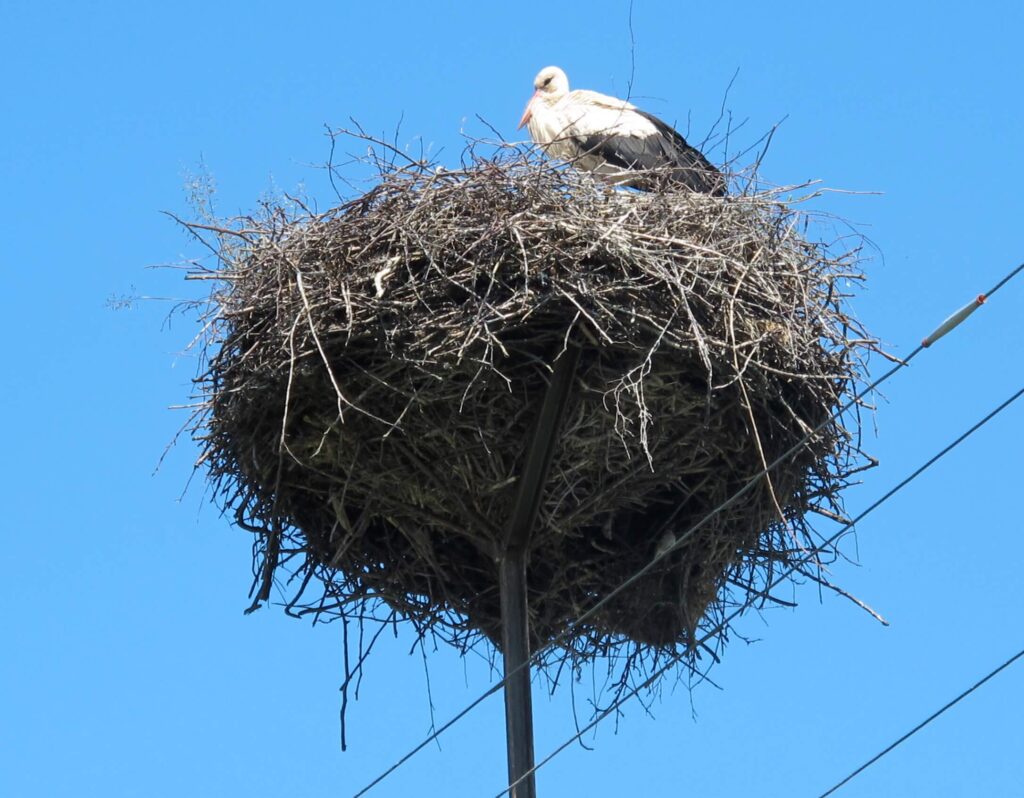
And the roads—the all-important roads—were just terrible. Not only when they were supposed to be terrible, understanding that as shunpikers we often seek out the roughest and most remote roads (and we weren’t disappointed there)—but even the major secondary roads, what would be called “A” roads in Britain or state highways in the U.S., were bone-jarringly rough.
Some of the country lanes that obviously dated from the communist era were literally hand-made—concrete blocks laid in parallel tracks across the countryside. No doubt another make-work program for a sluggish economy, like the pulpwood tree plantations. (I always remember bicycling through China in the mid ’80s, and seeing nine workers in the middle of the road on their hands and knees, painting the white lines, with different size brushes for outlining and filling them in. At least those nine people had jobs, I guess.)
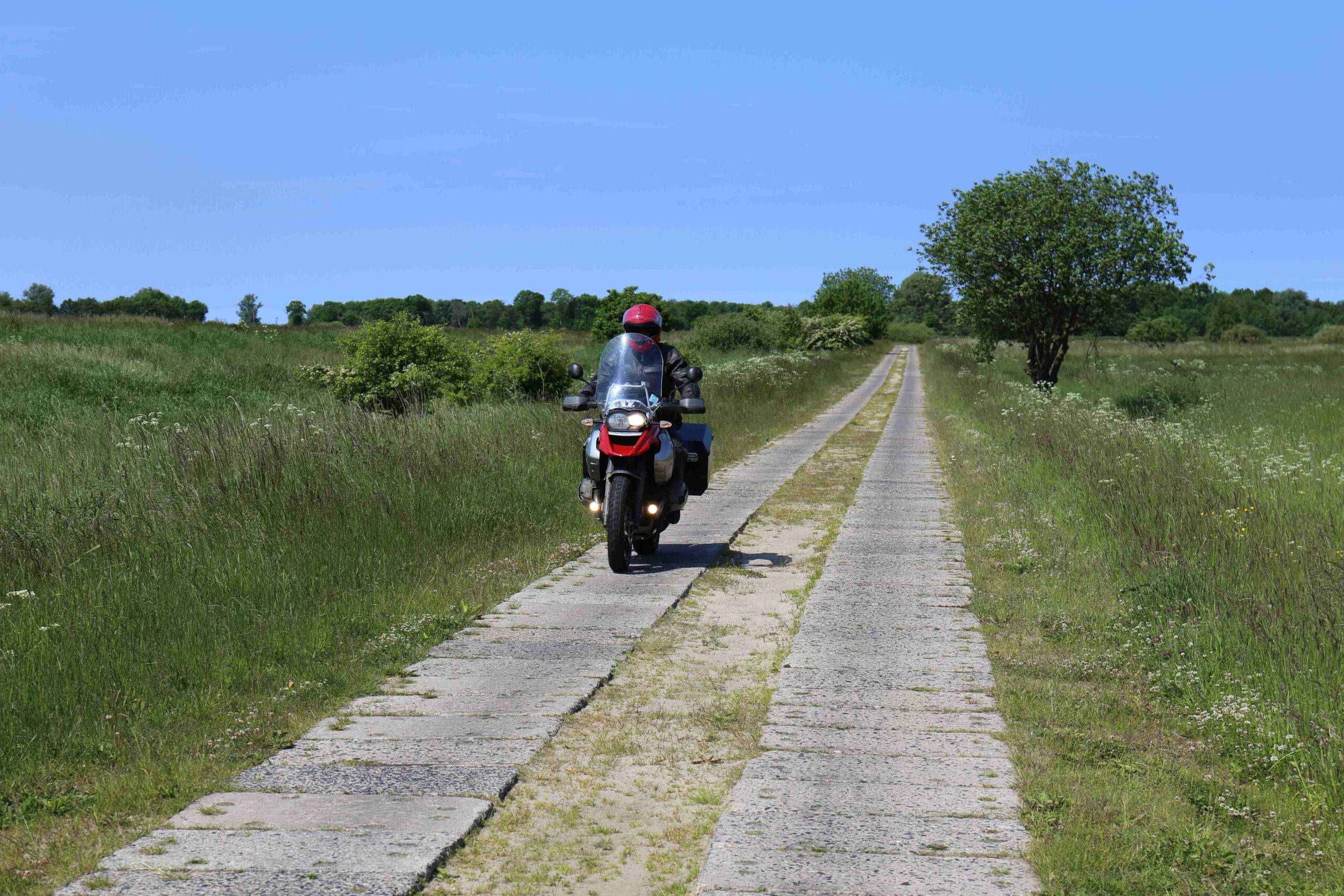
Photo by Brutus
And talk about Shadowlands . . . oh, Poland, poor Poland—tragically sited between the warlike pincers of Russia and Germany. (Something like a Mexican president said about his country, “Poor Mexico—so far from God, and so close to the United States.”)
My bandmate Geddy’s parents met as youngsters at Auschwitz, and he told me once how his mother recalled that when they were finally freed—after ninety per cent of Poland’s Jews had been exterminated—they were certain they must be the last people alive on Earth. Because if they had endured so much horror, and the world had allowed that to happen, how could anyone else have survived?
That notion inspired our song “Red Sector A,” with the lines, “Are we the last ones left alive?/ Are we the only human beings to survive?” The title gives the song a whiff of science fiction, which perhaps makes it seem less grim than the true history it relates, and that is fine with me. (In a now delicious irony, “Red Sector A” was the name of our viewing area as guests at the launch of the first Space Shuttle, Columbia, in 1981.)
A memoir by another female survivor of Auschwitz filled in more details, like how if anyone appeared too ill or feeble to work, they would be sent straight to the gas chambers. So even in that dehumanized nightmare, people showed “grace under pressure,” and tried to help each other appear “healthy.” (“For my father and my brother, it’s too late/ But I must help my mother stand up straight.”)
So as I rode through those Polish villages, I imagined those horrific times, the Jews being rounded up—or willingly surrendered by the local authorities—to be sent to their deaths in the Final Solution. Like the time Brutus and I spent a day visiting several of the World War One battlefields of France and Belgium, the stories that haunted us during our travels in Eastern Germany and Poland felt increasingly dark and heavy, and we were glad to board the overnight ferry to Sweden.
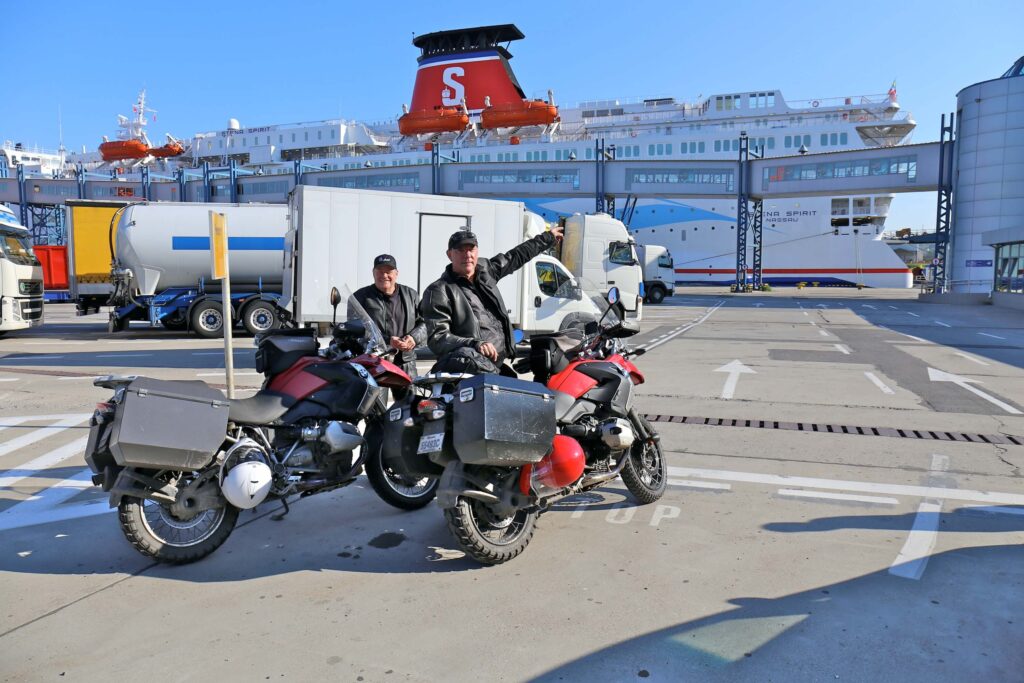
Photo by Michael Mosbach
And at last we can move on to happier, brighter subjects—like overnight ferry rides. Brutus and I just love those! Like the boat from Newcastle to Amsterdam, the Baltic ferries usually run overnight, so we could have “a full day” on the motorcycles, and get to the port by mid-afternoon. I never mind the waiting time, catching up on journal notes and the Sunday New York Times crossword saved from the previous Saturday’s International Herald Tribune, but you never know when Yellow Vest Man is going to appear and signal you to move—when you will have to quickly rearrange your belongings and riding gear, fire up the bike and get moving, to keep your place in line and not hold up others. Maybe you’ll ride a few hundred yards to where another Yellow Vest Man signals you to stop. That often happened three separate times, and even then you wouldn’t know if the motorcycles would be loaded first, or last. So the boarding process reminded me of one definition of soldiering—“long hours of boredom punctuated by moments of sheer panic.”
Once the bikes were safely tied down in the hold, though, we could check into our cabins and enjoy a pleasant dinner and the deepest sleep I have ever known—something about the low-frequency vibrations, or the sea air, I don’t know, but it’s certainly an effective soporific for this traveler.
For the price of a cheap flight and an average hotel, we traveled in luxury and pleasure—and for a few Euros more, Brutus booked us cabins in “Commodore” or “Panorama” class, with views over the bow of the ship. The word “posh” derives from British people traveling by ship, preferring “port out, starboard home” for cabins with the best views, so we were better than posh. And the restaurants were usually pretty good, too.
After breakfast (one ship waking its passengers one hour before arrival with Louis Armstrong’s “What a Wonderful World” playing over the ship’s PA—that was kind of nice), we hauled our luggage to the car decks (sometimes waiting a little too long there— though the camaraderie, and anonymity, among fellow riders could be sweet), then rode out into another “full day.”
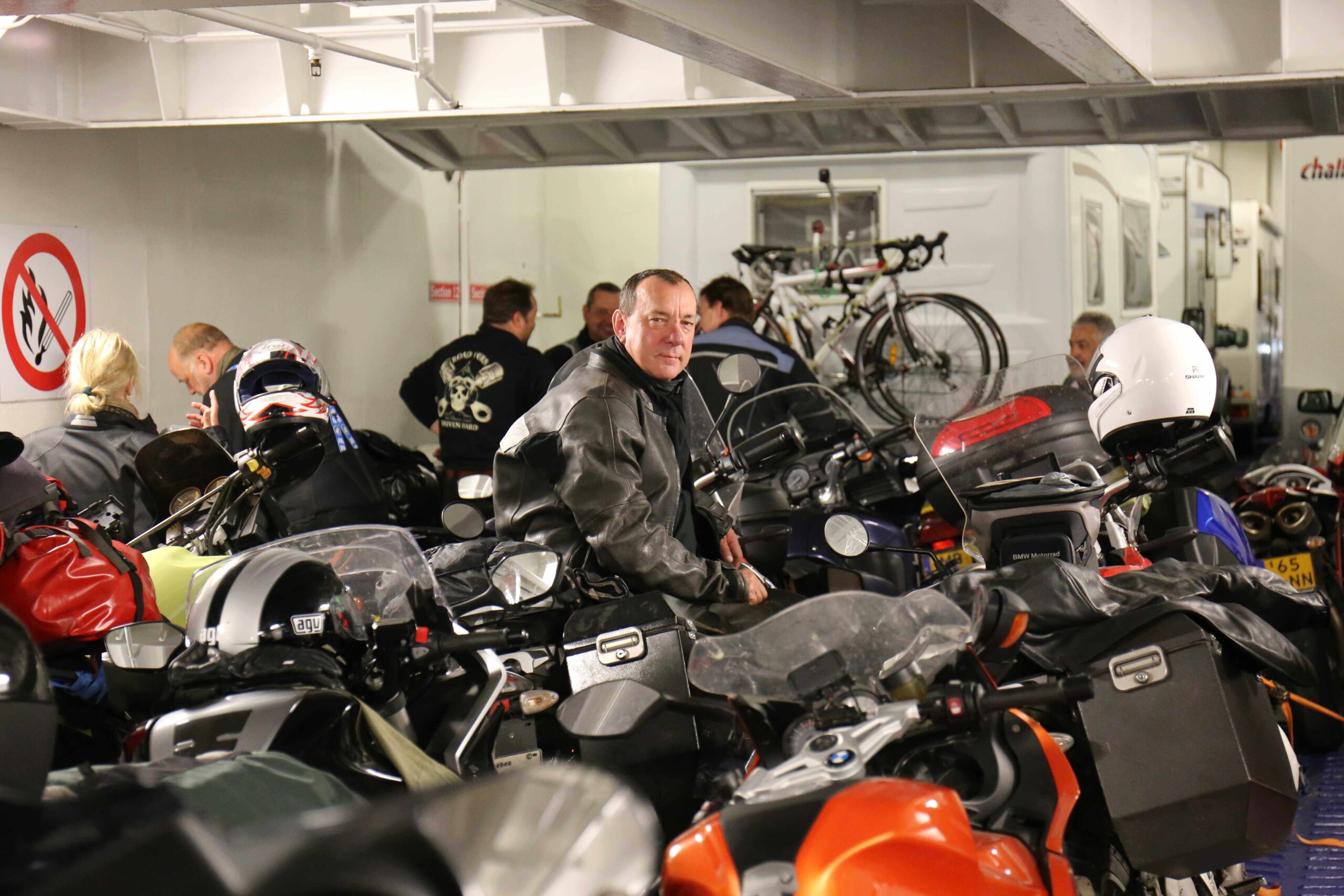
Photo by Brutus
Being off the boat and away on the shunpikers’ roads of Sweden and Finland brings me to a delicate subject—European driving standards versus their lack in North America. See, in four European tours now, Brutus and I have ridden thousands of miles of all kinds of roads, and not once—not one single time—have we encountered a driver who cut us off, flipped us off, ran us off, or did anything unexpected. No one has ever failed to use his or her turn indicators. (A bumper sticker I saw, “Jesus Would Have Used Turn Signals.”) And I seriously mean not a single exception—not one discourteous or unsafe move ever menaced our well-being on the road.
You could not survive a single day on the roads of Canada or the United States without having something ugly happen. Often many things.
Of course, Americans hate to hear that anything European might be at all superior, and Europeans are the same, in other ways. They may admire American blue jeans, rock and roll, jazz, action movies, and Route 66, but tend to generalize American people as morbidly obese, gun-toting religious fanatics. (A stereotype that’s only maybe fifty per cent true!)
That same half of the American population views Europeans as snooty, suspicious, snail-eating socialists. (Again, only half-right!)
But for all of these people on both sides of the Atlantic who have never seen the places or people they disparage, there’s a worthy quote from St. Augustine, “The world is a book and those who do not travel read only one page.”
I have also long admired a West African saying, “The one who does not travel knows only his mother’s cooking.”
On the theme of road manners, that wisdom might be amended to, “The one who does not travel knows only his father’s driving.”
One theory I consider likely is that Europeans lived communally for thousands of years, in which almost everyone was born, lived, and died among the same small group of people. So courtesy and responsibility were necessary. No one could get along without their neighbors, except aristocrats (who still sometimes simply chose such behavior as being more, well, aristocratic). Perhaps such social habits survived into modern times, when those medieval peasants and merchants began driving cars.
North America’s peoples came together in a much different way, arriving in small groups from widely-varying cultures, to places that were transitory and crude. Other individuals they encountered were all strangers—to be judged with suspicion, prickly hostility, and hair-trigger retaliation. And that is how they drive.
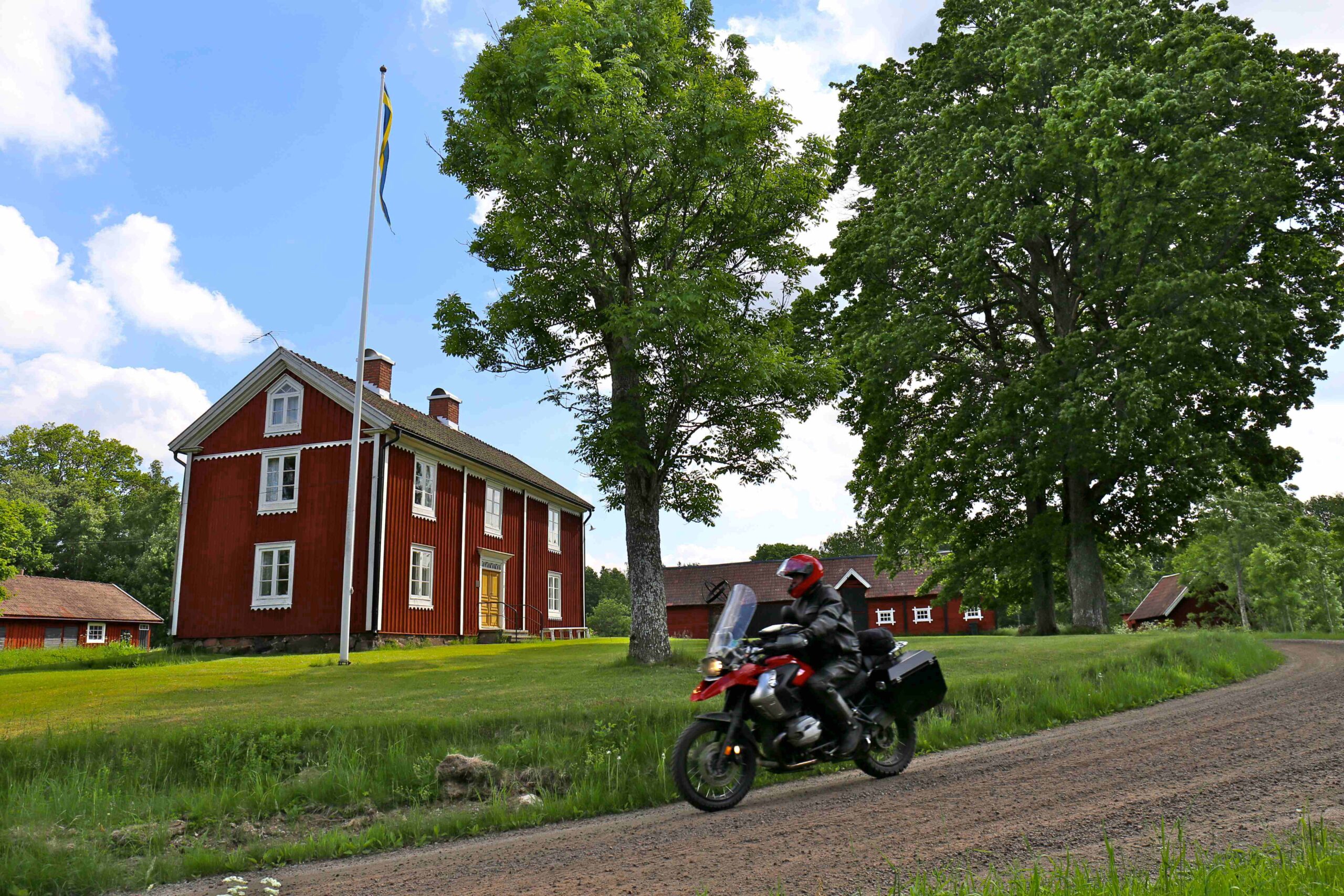
Photo by Brutus
Apart from quaint scenes like the above, and the area around the pretty island of Öland we visited on the Time Machine tour, the countryside of Southern Sweden is much like that of Southern Ontario, where I grew up, so maybe a little too familiar looking. We had some pleasant rides there, especially on the unpaved logging roads (much of Scandinavia, like large parts of Canada, is covered in vast stands of single-species pulpwood—though on an infinitely larger scale than Poland), and some paved backroads that were enjoyable enough, but straight and scenically . . . familiar. We didn’t stop too often for photographs.
Not having mentioned any of the actual shows yet, the one in Sweden provides an exceptional example. The arena concerts in the U.K, Amsterdam, and Germany had gone very well, the audiences enthusiastic, and we thought we were playing okay. The string section continued to be an uplifting presence, musically and socially. However, this was something far outside our usual performance routine—headlining one night of a huge three-day festival called Sweden Rocks. Bands were playing all day on three or four different stages, more-or-less continuously, so there would be no sound check. Our show would start a couple of hours later than usual, and instead of our two sets with intermission, we would play one long set, about two hours—and we would play to 35,000 people. That was a little overwhelming to contemplate, but I didn’t really have a sense of that crowd from the stage—with all the barricades and photo pits, even the closest people were farther away than usual. I really like to see people’s faces—to see them smiling, singing along, getting excited—but still, it was an impressive sea of humanity.
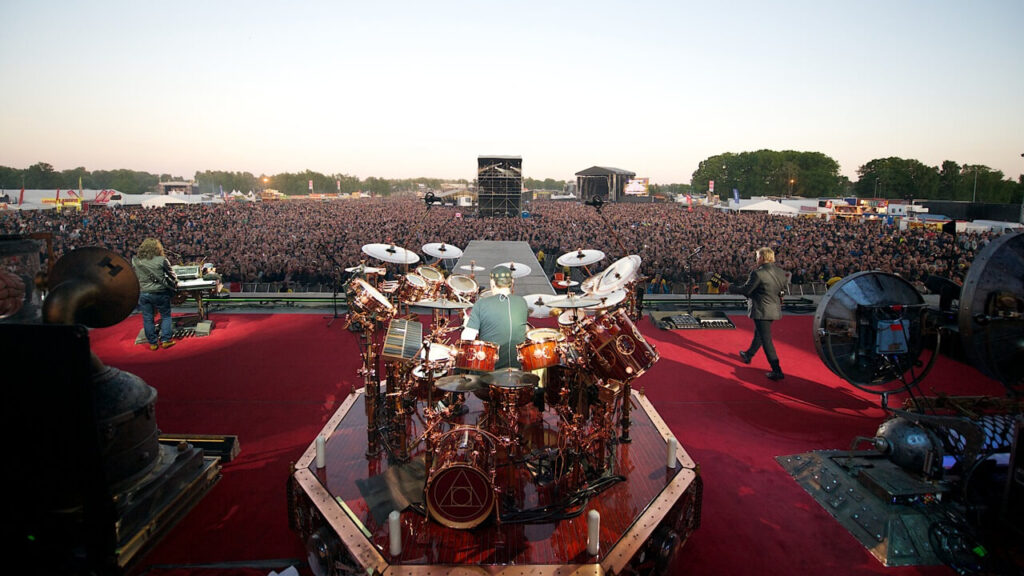
After another pleasant morning of shunpiking around Sweden, Brutus and I caught our third overnight ferry, from Stockholm to Turku, Finland. The ride through the city, certainly one of Europe’s prettiest, was gorgeous on that warm sunny day, and while waiting at the ferry dock, I had a transcendent experience. Because of the ten-hour time difference between Central Europe and Southern California, I had been able to have fairly regular video chats with three-and-a-half-year-old Olivia in late afternoons, when it was early morning at home. That day, sitting on my bike on its centerstand and working on the previous weekend’s crossword, I received a text from Carrie saying that Olivia wanted to see Daddy. I texted back that we were waiting for a ferry, and didn’t have Wifi. She replied, “Aren’t you always waiting for a ferry?”
Ha ha. It was really only the third time, but I felt bad that Olivia wanted to see me, and I couldn’t make it happen. I was determined to try to connect with her. The Wifi hotspot on Brutus’s phone didn’t work, but we picked up a signal from a nearby hotel’s free network. I gave it a try, and it worked!
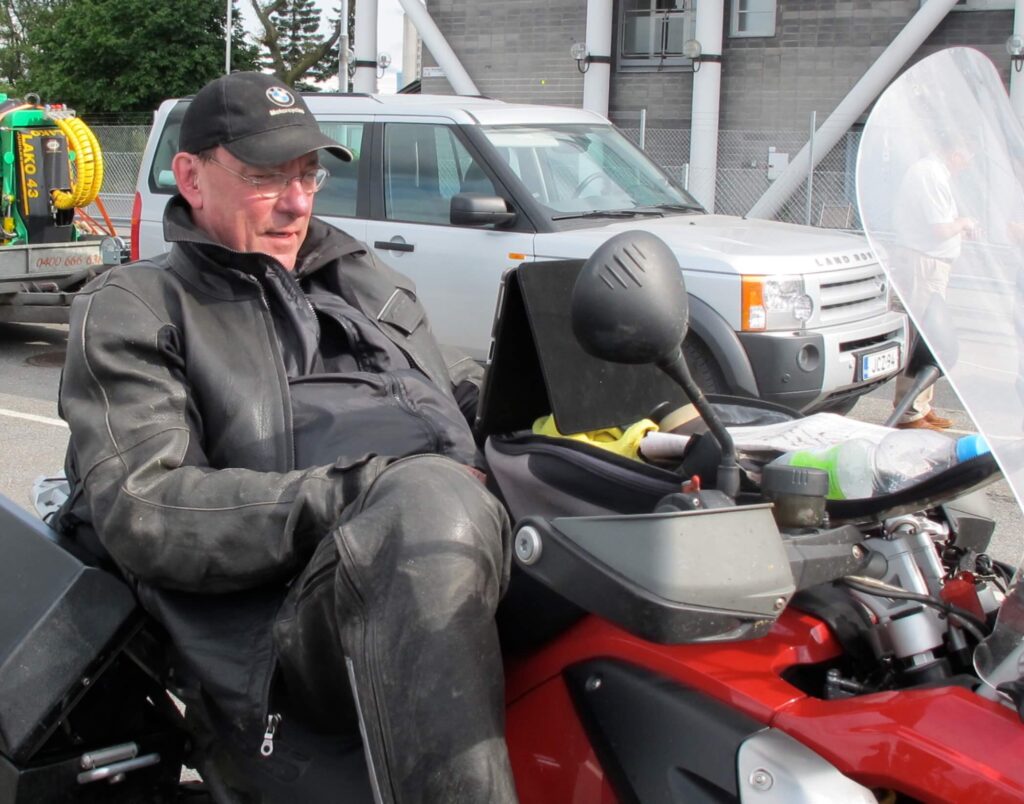
Usually my comment about modern gadgetry is, “Technology is never as smart as it thinks it is,” but when I saw Olivia’s smiling face on the little iPad screen perched on the tankbag of my motorcycle on a ferry dock in Sweden, I said to Brutus, “Now this is the way technology is supposed to work!”
I could show Olivia all around the harbor and the other boats, and even had Brutus take a photo of the scene on my cell phone, so I could send it to her and give her “the whole picture.”
Other passengers standing around were also delighted to hear Olivia belt out “I’ve Been Working on the Railroad” at full volume.
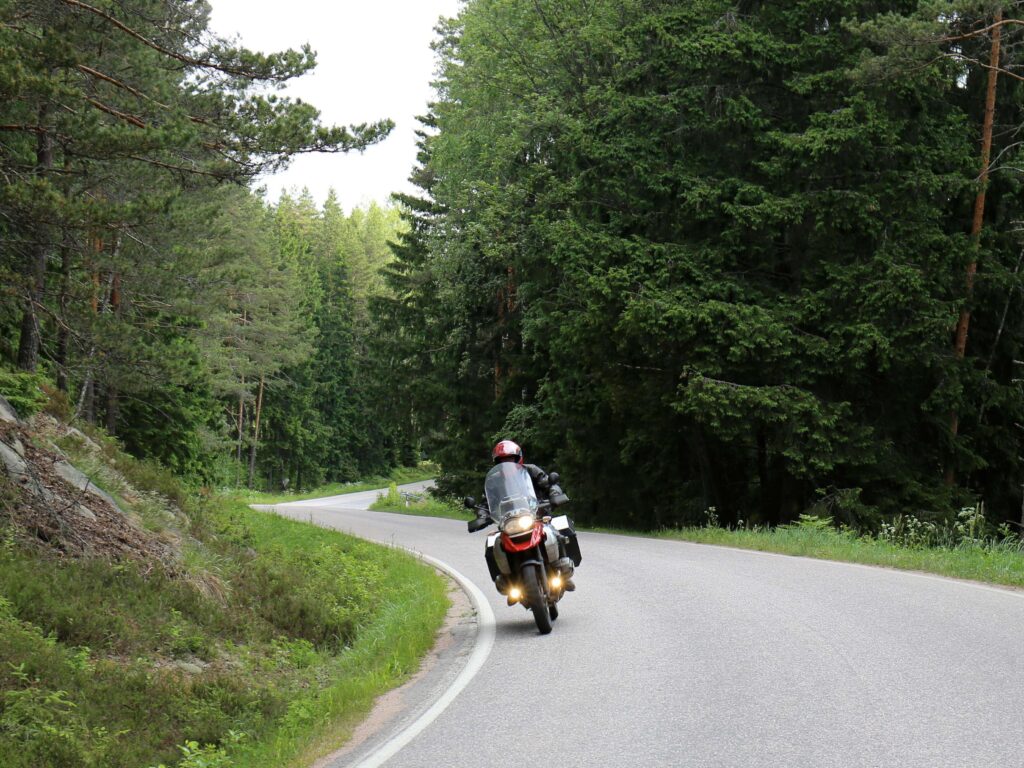
Photo by Brutus
Brutus and I had ridden in Finland twice before, but both encounters were brief and rainy. This time we had a dry and mostly bright day, plus a masterpiece of a route by Brutus that included all the good kinds of shunpikers’ roads—from logging tracks to lightly-traveled, nicely winding backroads through the rural countryside and mixed woodlands. (Forests cover three-quarters of Finland, though what we saw were second or third growth—but still, the trees were mixed somewhat “naturally” as opposed to the single-species plantations of Central Planning.) Among the familiar spruce, pine, and birch trees, I occasionally noticed a different kind of conifer, dark and drooping with graceful, gestural branches. As best I can deduce (just try to learn the name of one tree in the forests of Finland!), they were Finnish spruce, a variant of the Siberian species. In any case, just that one unfamiliar and attractive tree gave the woodlands of Finland a more exotic atmosphere.
Wildflowers were plentiful along the roadsides, seemingly scattered deliberately, as country people do. Yellow and white blossoms were most common, which seems typical everywhere, but there were bright splashes of red, like poppies. I was especially attracted to the multi-colored lupins, in pink, lavender, and purple spears, and asked Brutus to ride through one scene for me a couple of times. (Michael would have called me terrible names for that.)
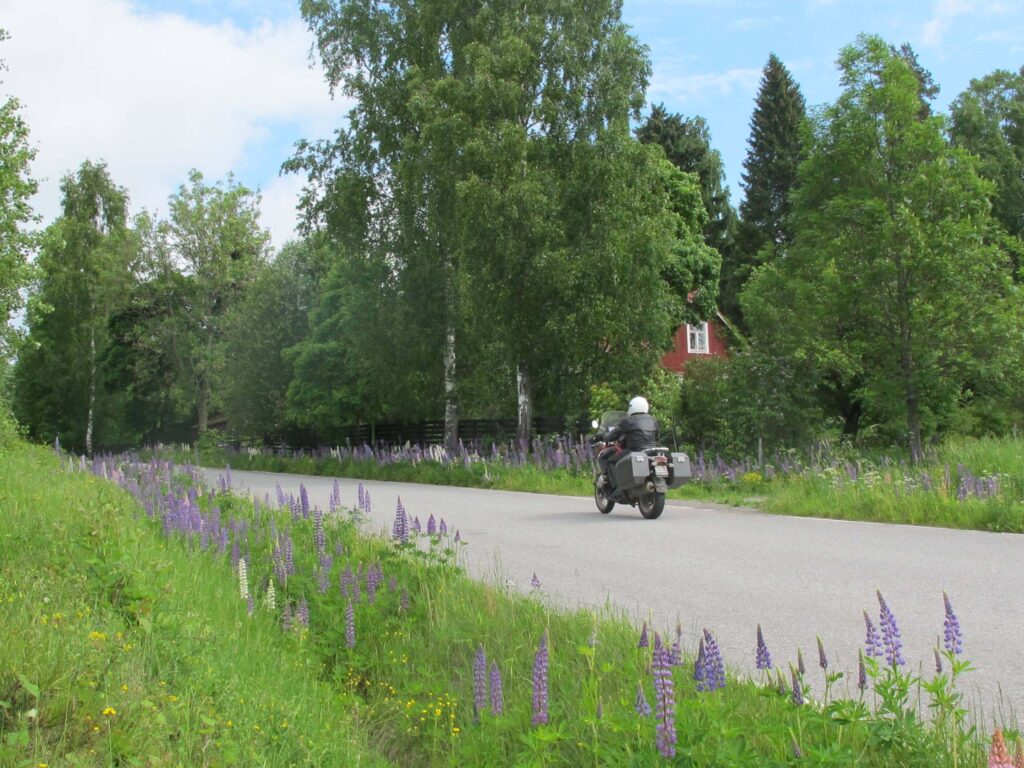
At such a northerly latitude, the growing season is brief but intense—summers are short, but the days are long, essentially giving twenty-four hours of light. The trees, pastures, and wildflowers around us seemed positively swollen with burgeoning life and color. It was now early June, and even at midnight, the sky was not completely dark. As in Northern Canada, only in winter do those people dwell in the Shadowlands.
But it’s a place we all pass through, some of us more than once, and Brutus and I had both survived some seriously dark times and trials. Often—like our journeys—we had shared them. Over the past year or two, Brutus had been through a particularly bad time, health-wise—cancer (stupid cancer, I insist it should always be prefaced), perhaps life’s ultimate Shadowlands. (Though grief would be close.) After multiple surgeries, therapies, and a dodgy prognosis, this European tour was Brutus’s first big motorcycle journey—so it represented a crucial “test” for him, a test of his future Quality of Life.
Without saying anything, I was a little anxious about his ability to handle it (serious traveling is hard work—like what Paul Theroux said, “When I come back from a journey, I haven’t had a vacation; I need a vacation”), and of course Brutus’s concern, and perhaps fear, ran deeper—all the way down.
A lot was riding on this tour, spoken and not, and as the days went by, I was happy and relieved to see Brutus making it—keeping up with me, and enjoying the ride. Out of all our darkness, he and I had emerged purified, ennobled, and enlightened—we knew how to appreciate life.
Riding into Helsinki for the final European show, after 5,314 kilometers, 3,321 miles, Brutus and I were a couple of happy shunpikers, riding out of the Shadowlands and into the light.

